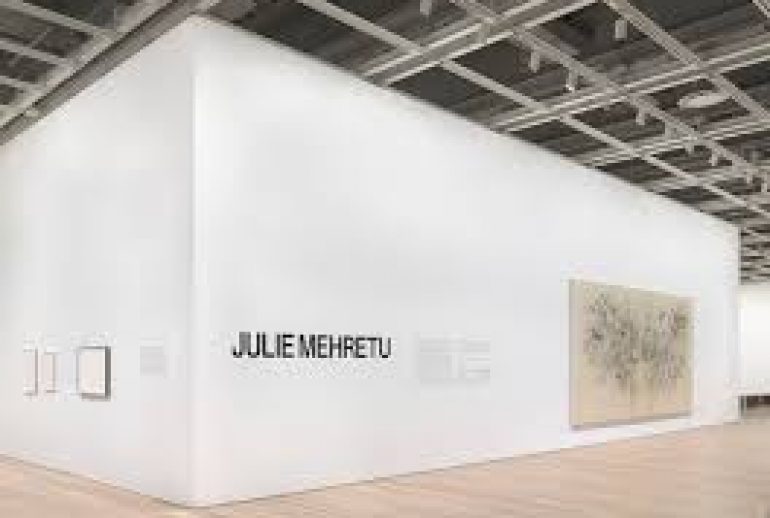“The aim of all commentary on art should now be to make works of art—and, by analogy, our own experience—more, rather than less, real to us. The function of criticism should be to show how it is what it is, even that it is what it is, rather than to show what it means” writes Susan Sontag in her 1964 essay, Against Interpretation. [1]
This has particular resonance for me as an architect when I look at many of the works that the artist, Julie Mehretu, exhibited from March 25 through August 8, 2021 at the Whitney Museum of Art in New York City (https://youtu.be/gaMM7g0uMcE). All of the work here is fascinating and galvanizing; much of it is monumental of a scale rarely seen in museums. But it is her paintings from the late 1990s through the 2010s such as Untitled 2 (1999); Back to Gondwanaland (2000); Babel Unleashed (2001); Retopistics: A Renegade Excavation (2001) Congress (2003); The Seven Acts of Mercy (2004); Palimpsest (old gods) (2006) and the series, Mogamma (A Painting in Four Parts) (2012) that speak to me as an architect. I am drawn to pattern, geometry, line, space, color and shape. These paintings—and others from the same period—are particularly intriguing because of the use of very precise draftsmanship to denote building elevations, structures and architectural elements, some of known places, other abstract representations, some overlapping and layered. In many of these paintings, they appear in the background, often hidden behind swooping, elongated shapes of color or patterns of black brush-like strokes and whip-like lines. However, in several works such as Projects (2008) and Aether (Venice) (2011), the architectural play dominates—ruminations in black ink on fantastical cityscapes, almost as if Julie Mehretu was rendering one of Italo Calvino’s Invisible Cities.
There are essays in the Whitney Museum of Art publication, “Julie Mehretu,” that was prepared in conjunction with the exhibition that strive to interpret for the reader the “meaning” of these paintings, often citing interviews with the artist herself. While no doubt valuable to anyone wishing to explore her work and history as an artist further, I would argue that the initial experience of seeing a painting is an aesthetic one—a reaction of the viewer to size, color, shape, form, pattern, line and texture. As Susan Sontag argues, “one did not ask of a work of art what it said because one knew (or thought one knew) what it did.” [2]And further, “…the idea of content is today mainly a hindrance, a nuisance, a subtle or not so subtle philistinism.” [3] I am interested in the question of “What would criticism look like that would serve the work of art, not usurp its place?” [4]
And so I ask myself, what do I “see” when I look at these paintings? In many of these works, the exacting and exquisite draftsmanship in thin black lines of architectural constructions are in tension with color, shape and movement, denoting rigidity and permanence, authority. Recognizable elements, although skewed and ordered by seemingly scattered points of perspective, bring a scale to the artwork—a way for the visitor to place him or herself in the painting despite the enormity of the canvas. Yet these same elements also engender in the viewer a sense of anonymity—I could be only one or I could be one of many in each of these worlds that Julie Mehretu has created.
She uses her vocabulary to an almost violent effect. Emanating from the center of works such as Renegade Delirium, Dispersion, Looking to a Bright New Future and Congress is a vortex of movement—of color, shape, form and line thrusting the viewer to the limits of the canvas, and sometimes seemingly beyond. More than a passing glance at any of these paintings requires the observer to actively explore its surface—from a distance to try and get a sense of the whole, and hovering up close to carefully examine the myriad of detail.
Then there is the confusion about time. Paintings such as Aether (Venice), Invisible Line (collective) and Mogamma (A Painting in Four Parts) each depict buildings that are at least, in part, recognizable. But the buildings within these paintings are not always of the same time. This creates a sense to the observer that what is depicted could be of any time, or no specific time at all. It is a kind of timelessness that points to the immutability of architecture.
And so what I see is an artist who uses architecture because it has meaning for her and it is forces the viewer to think, what meaning does it have for me? We are challenged to consider how we react to architecture through the medium of painting—a reminder that architecture is a social construct, and one of the reasons why her work is so important.
[1] Susan Sontag, Against Interpretation and Other Essays (New York, Picador, 1966), p. 14.
[2] Ibid, p. 4-5
[3] Ibid, page 5.
[4] Ibid, page 12.

